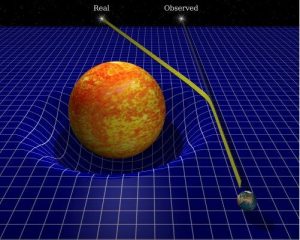It has been famously stated that if Albert Einstein hadn’t published his theory of special relativity, someone else likely would have within the decade. But if Einstein hadn’t published his theory of general relativity we would still be waiting on that discovery to this day. The theory of general relativity, proposed by Einstein in 1915, is one of the most profound and revolutionary achievements in the history of science and transformed our understanding of space, time, and gravity.
Background on the Theory of General Relativity
For nearly two centuries, Isaac Newton’s law of universal gravitation stood unquestioned and unchallenged in the field of physics. However, around the end of the 19th century some tiny, yet vulnerable, kinks in its armor were beginning to emerge. Physicists noticed it was unable to explain certain phenomena, such as the orbit of Mercury. They were also struggling to reconcile classical mechanics with new observations of the nature of light and electromagnetism. A relatively unknown physicist at the time named Albert Einstein provided the solutions to these vexing problems.
Einstein’s journey towards his theory of general relativity began in 1905 with the publication of his theory of special relativity. Special relativity primarily focuses on objects moving at a constant speed. It ignores acceleration, or objects affected by gravity, which Einstein determined are essentially the same thing after he formulated general relativity.
Between 1907 and 1915 Einstein worked extending of his theory of special relativity to include gravity. The mathematical complexity of this task proved enormous, and so Einstein had to learn various advanced mathematical techniques to complete his ideas. He worked with other mathematicians the help him understand the underlying math needed to formulate his ideas.
Space, Time, and a Sliver of Curvature
In November 1915, Einstein presented his revolutionary ideas on general relativity to the Prussian Academy of Science. His theory describes how mass and energy curve the fabric of spacetime, effectively producing the force of gravity. Therefore, a major implication of general relativity is that it redefined gravity from a force acting at a distance to a description of gravity as a geometric property of spacetime. The core of general relativity is the field equations, which explain the geometry of four-dimensional spacetime to the distribution of mass and energy within it. These equations are known as the Einstein field equations.
General relativity also implies an equivalence principle. This states that the effects of gravity are locally indistinguishable from the effects of acceleration. In other word, someone in a closed space cannot determine whether they are feeling the effects of gravity or acceleration. A classic example is the elevator thought experiment. Imagine you are in an elevator with no windows. If you drop an object it falls to the floor at an acceleration of 9.81 m/s^2 due to earth’s gravity. However, you could also be in distant space, far away from any gravitational force accelerating at a constant rate of 9.81m/s^2. In the second scenario when you drop an object it will also fall to the floor at an acceleration of 9.81m/s^2 – the effects of the two scenarios are indistinguishable.
Testing and Acceptance
General relativity has been repeatedly verified by observation and experimentation. One of the first key confirmations of general relativity came in 1919 during a solar eclipse expedition by Sir Arthur Eddington. To goal of the expedition was to measure the apparent shift of the stars near the sun during the solar eclipse. Indeed, the observed shift matched the predictions made by general relativity.
Another significant test of general relativity was the perihelion precession of Mercury’s orbit. Mercury’s orbit exhibits a small deviation in the orientation of its elliptical orbit over time, a phenomenon known as perihelion precession. Prior to general relativity, astronomers struggled to account for the advance of this phenomenon. Newtonian classical mechanics failed to explain the discrepancy. However, when Einsteins equations of general relativity were applied to this problem, they yielded an answer that matched the observed rate of precession. This successful prediction, along with the results of Eddington’s experiment, provided crucial empirical evidence for the validity of general relativity. General relativity also predicts other phenomenon such as gravitational redshift and time dilation, both of which have been confirmed through experiments as well.
As empirical validation rolled in, general relativity gradually began to gain acceptance within the scientific community. By the latter half of the 20th century, general relativity had become fully accepted and became one of the two twin pillars of physics – along with quantum mechanics. The acceptance of general relativity can be viewed as a watershed moment in the history of science, marking the transition from the Newtonian worldview to that of a relativistic worldview.
Continue reading more about the exciting history of science!

